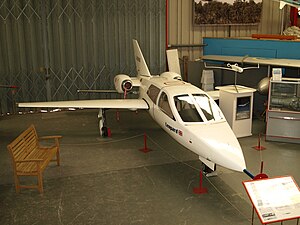|
CMC Leopard
The CMC Leopard was a British light personal business jet developed in the 1980s. Two prototypes were built and flown, but the type was never put into production. Design and developmentThe Leopard was a twin-jet, mid-wing monoplane of composite construction with all-swept flying surfaces and jet fighter-like styling, apart from the podded engines, mounted on each side of the rear fuselage. The entire canopy hinged forward to allow access to the four reclining seats.[1] A mockup was completed in 1982, leading to a prototype (registration G-BKRL[2]) built by the Designability company. The prototype first flew late in 1988. Development suffered a major setback when the engine manufacturer, Noel Penny Turbines, ceased business, leading to the grounding of the prototype. A second, refined prototype (registration G-BRNM[3]) was then constructed to use Williams International turbofans. This aircraft also incorporated a pressurised cabin, revised undercarriage, and a generally strengthened airframe. This second prototype was unveiled at the 1996 Farnborough International Airshow and first flew on 9 April 1997. The project never progressed beyond the two aircraft built, later redesignated Leopard Four to distinguish them from a six-seat variant proposed in 2001, the Leopard Six. The EJ22 engine could no longer be used due to exclusive deal between Williams and Eclipse,[4] resulting in the Six being proposed to make use of the larger FJ33. Chief aircraft designer and CMC chairman Ian Chichester-Miles died in 2009, bringing the enterprise to an end.[5] Aircraft on display Until 2007, both prototype Leopards, G-BKRL and G-BRNM, were on display at the Bournemouth Aviation Museum. With the museum temporary closure and relocation in 2008, only the former was retained and moved to the new site, while G-BRNM was acquired by the Midland Air Museum at Coventry Airport.[6][7] Specifications (second prototype)General characteristics
Performance
ReferencesWikimedia Commons has media related to CMC Leopard.
|
||||||||||||||||||
